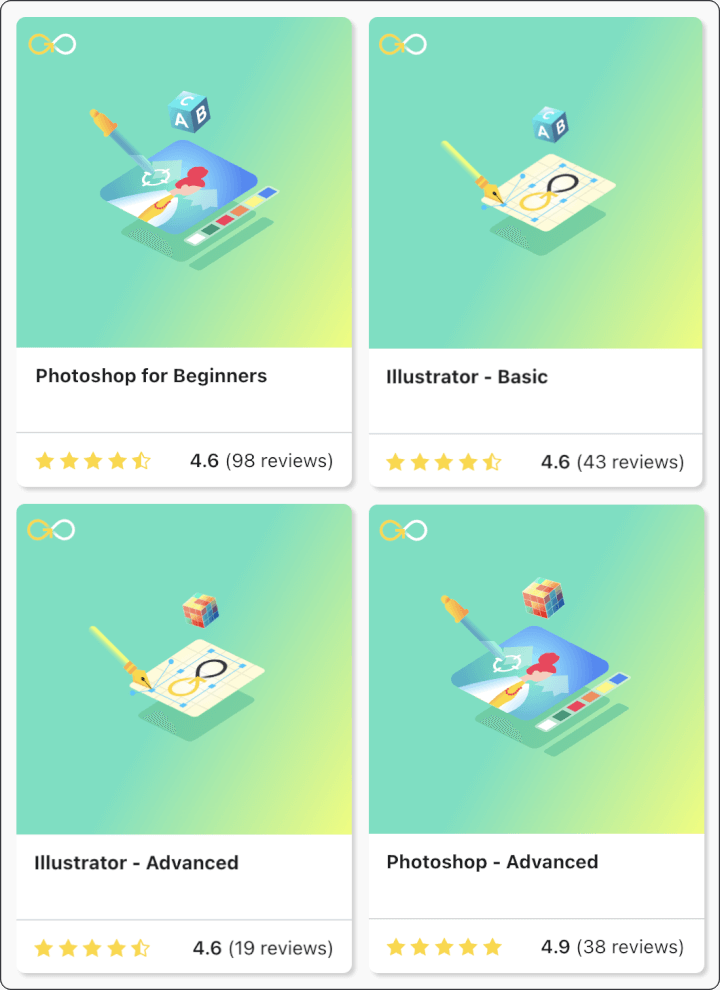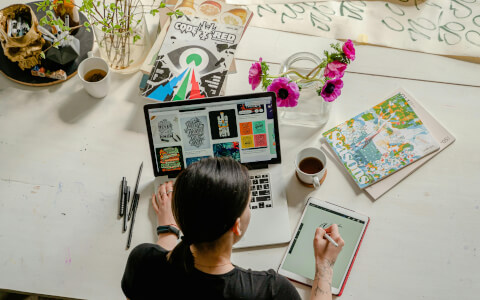Tools help us create the things we need, like, or dream about. A chef uses fire to make culinary magic. Musicians use instruments to play a tune. Engineers need the right equipment and set of materials to construct a bridge people cross from one point of suspended space to another.
Similarly, graphic designers need more than just talent or skill to create visual art. To produce compelling visuals, graphic designers use simple and sophisticated graphic design tools that capture the ever-shifting shapes and colors in their mind.
From Renaissance-era brushes to the electronic stylus, the tools of graphic design continue to evolve dramatically. And so do the audiences and market for visual art. To be a successful graphic designer in the digital age, you have to learn multiple skills and become proficient in a wide array of graphic design tools that help you create much faster, easier, and with more impact.
There are many to choose from, but here are 17 essential tools for graphic designers aiming to unleash the visual experiences of tomorrow.
Want to learn more about graphic design?
Download the beginner's guide now!
Hardware
1. Pen and paper
The fastest, cheapest, and easiest way to transfer design ideas from your head to the real world is to use a good old pen and paper. Besides giving you a chance to stay off the grid for a few moments, analog sketches also serve somewhat like the sacred link between the great graphic artists of the past and the new tech-enabled designers of today.
More importantly, using pen and paper allows you to “intuitively draw” the design concepts in your mind and quickly discover problems and solutions as your sketches take a rudimentary shape. Research even shows that taking notes, doodling, and writing by hand enhances focus, creativity, and openness to learning.
If you’re passionate about this creative method, then go all the way by investing in iconic pencils (Rotring, Faber-Castell, etc) and notebook brands (Moleskine, Field Notes, etc.).
2. Computer
For digital creatives, this is the ultimate tool that performs all the heavy lifting. If you can afford the best and most powerful — the iMac Pro or the Surface Studio, for example — do so by all means.
The iMac commands a loyal following of hardcore designers largely by including coolness in its core features. Meanwhile, Microsoft Surface Studio is a worthy rival capable of shifting the balance by giving PC loyalists major bragging rights for (finally) owning something remarkably sleek, powerful, and agile — all in one surprisingly elegant package.
However, if these dream workhorses would make your wallet groan, there’s no shame in making do with what the rest of humanity uses. Any decent computer that can adequately handle graphics software and reliably connect to the cloud can sustain your life as a modern-day graphics designer.
3. Stylus and graphics tablet
Creatives who have a dominant tech gene in their DNA will likely prefer the digital equivalent of pencil and paper for their sketching and doodling tasks. When it comes down to it, even their more traditional cousins who sleep with analog pens in hand sometimes seek the souped-up functionalities of an electronic pencil and paper.
So if you find yourself craving a hybrid tool that allows you to continue making hand drawings like a classical artist but using the tools of a tech geek, don’t be embarrassed nor feel that you are betraying the trade. Instead, check out state-of-the-art tools such as the industry standard Wacom tablet/Pro Pen and the versatile iPad Pro in tandem with the Apple Pencil.
Either could simulate the authentic feel of drawing sketches or creating wireframes, in addition to giving you some wicked capabilities (instant color, filters, eraser, storage, superb editing, etc.) that you just can’t execute using ordinary pen and paper.

4. Smartphone
This gadget helps us connect with peers, customers, and the world wide web. It also hosts your favorite apps — including really handy on-the-go drawing and image-editing tools. Plus, the smartphone doubles as a decent camera for unexpected moments when you need one and your sturdy Canon or Nikon is snug as a bug inside its case back at home.
For web designers, a smartphone on hand is also the easiest way to find out whether a specific web page design properly renders on small screens. As can be expected, graphic designers don’t agree on which smartphone model is the best for their profession, but you’ll find loud voices supporting either Samsung’s flagship Galaxy S phones as well as Apple’s latest iPhone iteration.
5. Camera
For creatives who need to take, edit, and manage hyper-precise photos and videos, nothing but a decent DSLR (Digital Single Lens Reflex) will do. And when DSLRs are concerned, two iconic brands — the Canon EOS and Nikon D-series — lead the pack. Both are pricey of course and if budget is a big issue, there are more affordable alternatives in the market that are also capable of capturing pixel-perfect shots.
6. Color space reference
Never settle for counterfeit colors. For the uninitiated, a shade of color that resembles blue might as well be blue, but for design professionals, color accuracy and rendering precision matter big time.
If your work has a significant print component, having a color space reference is a must. The Pantone Matching System is recognized as the industry standard and you can invest in the Formula Guide for nearly 2000 spot colors, the basic Color Bridge Set, or mini Color Swatches depending on your client portfolio and design focus.
7. Monitor calibrator
Another way to control runaway colors is to use monitor calibrators. These devices ensure that the colors you see on your screen will be exactly the same ones that come out in printed outputs such as posters, brochures, and magazines.
X-Rite and Datacolor are the leading monitor calibrator brands, with ColorMunki Smile and Spyder5EXPRESS as their respective entry-level models.
8. Storage
While cloud storage is already available, many graphic designers still opt to have physical backup storage devices close at hand. Because entire libraries of images and videos can easily eat up storage space, you may want to invest in high-capacity, portable models such My PassPort series from Western Digital and MiniStation Extreme NFC from Buffalo.
Choose models with at least a terabyte of storage. Designers who have larger budgets and prefer super-fast plug-and-play processing will likely go for solid state drives (SSD). If you belong to this group, then Samsung’s T3 SSD — which comes with 1-terabyte of storage space — is a good option.

Software
9. Graphic design applications
This is the largest and arguably most important part of a digital artist’s tool stack. Whether installed to run from a desktop computer or offered as a cloud-based service, these software applications enable graphic designers to create, edit, store, and manage their creative output: photos, images, videos, presentations, brochures, and other visual formats.
The Adobe Creative Cloud sets the standard for this tool type, providing a full suite of applications for creating and manipulating raster graphics (Photoshop), vector images (Illustrator), videos (After Effects, Premiere Pro), and different desktop publishing formats such as posters, magazines, brochures, and ebooks (InDesign).
Paid alternatives to specific applications in Adobe’s subscription service include Serif’s Affinity Designer (vector) and Affinity Photo (raster), CorelDRAW (vector), and the macOS-exclusive Sketch (vector).
Free tools with similar capabilities include Vectornator, a vector-based illustration software, GIMP (GNU Image Manipulation Program) for authoring and manipulating raster images, and Inkscape for creating and editing vector graphics.
10. Online graphic design services
With the advance of cloud computing technology, several companies have started offering web-based graphic design services that primarily target general consumers (i.e., non-professional/occasional designers).
Foremost among these providers is Canva, a simple drag-and-drop online tool that allows anyone to quickly author, edit, and share images. The website is perfect for non-designers as well as hardcore creatives occasionally looking for a quick way to create images for various purposes (e.g., blog illustrations, social media posts, etc.) and in various formats (e.g., infographics, presentations, header images, etc.). Snappa offers a similar service and interface, or you might consider Design Wizard to quickly create both images and videos.
For logo and branding-specific design options, you can try ZillionDesigns' free logo creator. They offer a ton of templates with an easy-to-use interface.
To present new learning concepts, objectives or plans, Visme can come in handy. It provides pre-designed presentation templates that you can customize to your needs by simply dragging and dropping - no design skills needed. With lots of charts, icons, images, and many other graphics, you'll visualize your information, making it memorable and easy to digest for students.
Another option is Venngage, a template-based design tool that lets anyone create professional content like business presentations, white papers, reports, marketing materials, and more. The tool provides users with access to over 10,000 icons, thousands of stock photos, and tons of customizable charts and graphs.
In addition to these tools, Envato Elements stands out as a comprehensive resource for designers seeking to find all the creative assets they need in one place. This marketplace offers unlimited downloads of high-quality design templates, stock photos, graphics, and more for a flat monthly fee. This service is valuable for both seasoned designers and beginners, providing access to a vast library that includes fonts, add-ons, and even video templates.
Finally, you can use Pixlr for simple photo-editing online; Invision for collaborative screen prototyping, and Artboard Studio for quickly creating product mockups.
11. Artificial Intelligence
Generative AI like ChatGPT and Google Gemini have already taken the world by storm. This highly disruptive technology closely replicates the human ability to reason and create, capable of quickly producing magazine articles, frame-worthy imagery, danceable music, computer code, and compelling videos.
For graphic designers, this might seem threatening. AI services like DALL-E and Midjourney can generate images from natural language descriptions in mere seconds -- something nearly impossible for even the most prolific human artists. But take heart. A growing number of practitioners opt to view generative AI not as an existential threat but as a powerful tool for augmenting the human imagination, improving digital workflows, and enhancing creative outputs.
Think of it this way. With AI, there simply is no going back. You either embrace it as a force multiplier or allow insecurity to limit your professional growth -- while your peers get more proficient in prompt-engineering their next masterpieces. By using AI merely as a tool, you acquire new and powerful capabilities without surrendering your aesthetic soul.
12. Graphics repositories
Online libraries of images such as Shutterstock, Behance, and Depositphotos are great places to visit and get design ideas from. Some of these repositories (such as Pixabay, Pixelify, and Unsplash) even provide free downloadable images you can legally use in your projects.
13. Cloud storage
You have your hard drive and portable storage. That's well and good, but you still need a space in the cloud to store, synchronize, and manage your design assets, projects, and output. Among other things, cloud storage makes it easier to share and collaborate on design documents, besides being accessible anytime and anywhere — which is hardly the case when you forgot to bring your portable physical drive to work.
Creating a profile or an account for some online services can entitle you to limited cloud storage space. This is the case when you have accounts for Google (Google Drive), Microsoft (OneDrive), and Adobe (Document Cloud). Cloud storage providers such as pCloud, Dropbox, and MediaFire also give free storage space. However, free options generally entitle you to only 1GB to 15GB of free space so you might want to check out subscription fees at these services if you need larger storage.

Instruction, insight, and inspiration
14. Portfolio
Even a humble graphic designer needs to have some form of conceit to show off her creations. Portfolio website services such as Appy Pie's Website Builder, Wix, HubSpot, SquareSpace, and Adobe Portfolio (Behance) help designers consolidate and curate the creative efforts they are proud of, and communicate their credentials to prospective employers, clients, and peers. Heck, what better thing to do with artwork than to share it with the world?
15. Training
The field of design is in constant flux as technology, aesthetic standards, and markets shift. This means designers always need to improve their knowledge of the craft and develop new skills that will enable them to produce creative outputs that will remain relevant and meaningful to their intended audiences. Learning portals like GoSkills are great websites for learning new trends and techniques in graphic design.

16. Resource sites
Creatives are arguably the subset of professionals most in need of inspiration. Besides getting that from their immediate environment (hopefully), these professionals can visit design-focused websites that publish advice, tips, and doses of inspirational materials that can help motivate stressed-out or low-energy designers. Behance, Abduzeedo, Uncrate, and Google Arts & Culture are some of the best places in cyberspace that can ignite that creative spark in you.
If you're working on specific sub-spaces within the design space, check out agency sites that specialize in those services to get inspiration from their portfolio or case studies. For example, a creative in-motion animation could get inspiration from this motion graphic services page.
17. Your own workspace/creative nook
Designers differ when it comes to how an inspiring workstation should look like. Some prefer extremely minimalist themes, while others clutter their spaces with toys, nostalgic memorabilia, and other eye candies. Depending on your aesthetic sensibilities, transform your workspaces so they can become an integral and proactive component of your workflow. Consider lighting, color schemes, access to windows, and ergonomics when designing and setting up your own creative nook.
Final takeaways
Graphic design is a competitive and challenging field. Practitioners looking to future-proof their careers need to keep their design skills sharp and their knowledge of trade tools always updated.
Whether you have been a graphic designer for some time or have just found your way into this exciting field, these graphic design tools can help you achieve your creative potential.
In any case, you can refresh your skills in manipulating raster and vector images with our Photoshop and Illustrator courses. Or, you can consider learning the allied field of web design to augment your competencies as a digital design professional.
Thinking about whether to choose a career in graphic design or web development? Check out this guide to help you decide.
Happy learning!
Level up your design skills
Start learning for free with GoSkills courses
Start free trial



